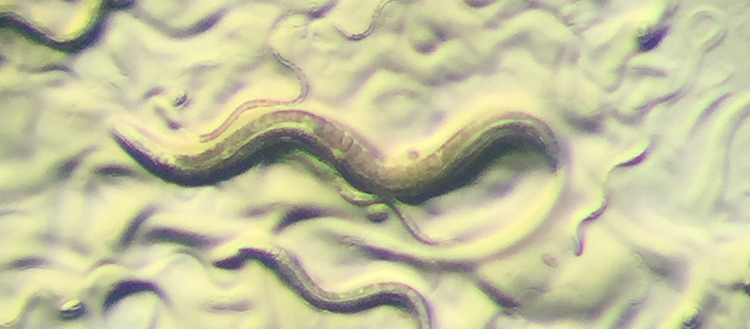Inherited memories of a chromosomal site
Two UNIGE teams have discovered that the location of a specific chromosomal site is transmitted between two generations, even if the part of the protein that initially defines that site is absent in the offspring.

A Caenorhabditis elegans nematode surrounded by offspring at different stages (eggs and larvae). © UNIGE
Most biological traits are inherited through genes, but there are exceptions to this rule. Two teams from the University of Geneva (UNIGE) have been investigating the location of centromeres – specific sites on chromosomes that are essential for cell division. They found that in the small worm Caenorhabiditis elegans, the transmission of the correct location of these sites to the offspring is not mediated by genes, but by an epigenetic memory mechanism. These results have been published in the journal PLOS Biology.
Living organisms, from humans to microscopic worms, inherit physical and sometimes behavioral traits from their parents. The transmission of biological traits is usually mediated by DNA which is replicated at each cell division and contains the genes. However, some characteristics can be transmitted from one generation to the next independently of genes: these are epigenetic phenomena.
A transparent organism to observe the segregation of chromosomes
By studying the physical separation of chromosomes into the two daughter cells during cell division, scientists at the UNIGE have been able to identify one such epigenetic process. The team of Florian Steiner, professor in the Department of Molecular Biology at the UNIGE Faculty of Science and last author of this study, is investigating centromeres in the nematode Caenorhabditis elegans. These specific chromosomal structures serve as anchors for the machinery responsible for the correct distribution of the chromosomes to the daughter cells: a defect in this distribution can result in cell death but is also frequently observed in cancerous cells. “Studying these processes is greatly facilitated in C. elegans, since this small worm is transparent and allows live observation of cell divisions and the fate of chromosomes from one generation to the next”, explains Reinier Prosée, researcher in the Department of Molecular Biology at the UNIGE Faculty of Science and first author of the study.
A memory transmitted only to the next generation
The location of the centromere on the chromosome is defined by a protein that biologists study in the group of both Florian Steiner and Monica Gotta, professor at the UNIGE Faculty of Medicine. These research groups together discovered that the protein finds its right location on the chromosome to define the centromere thanks to a particular region that serves as a guide. They then created a mutant whose DNA lacks the piece that codes for this ‘guide’ region of the protein. “The prediction was that this mutant would not be viable, since the position of the centromere could not be defined in the absence of the guide part of the protein. This, we expected, would lead to the incorrect distribution of chromosomes”, explains Florian Steiner. “However, we found that even in the absence of this ‘guide’ region, the truncated protein positions itself correctly and is functional. The worms are therefore perfectly viable!” Reinier Prosée continues. It turns out that once the centromeric sites are correctly defined in the mother, this information is transmitted to the next generation thanks to cells ‘remembering’ the correct location of these sites, even in the absence of the part of the gene that codes for the ‘guide’ region of the protein.
In contrast, the offspring of the mutant worms cannot divide their cells properly and therefore do not survive. This is because the offspring have not inherited information about the correct position of the centromeric sites from their mutant mother. This particular epigenetic memory only lasts for one generation and is not transmitted to the next. “We will now test our hypotheses to explain the epigenetic mechanism by which this memory is established and persists during development”, concludes Florian Steiner.
